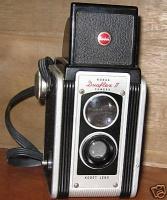
It’s been announced that this latest run of Kodachrome film will be the last ever. Â The news took me back to the first camera I owned, similar to that pictured above.
I remember that camera fondly. Â I picked it up at a garage sale for the whopping price of fifty cents. Â I had a lot of fun then, and it was a real treat to carefully remove the film, take it to the shop for development. Â Â I still remember the Fotomats that used to do shopping centers. Â One of the photos I took was printed in my high school yearbook. Â It was a photo I’d taken at our Marching Band’s appearance at a Ronald Reagan campaign stop in Lima, Ohio. Â It was his second election in 1984. Â He was on a train travelling through Northwest Ohio in the Ferdinand Magellan.
Anyway, it’s funny how those mentions of things can trigger certain pleasant (and at times unpleasant) memories. Â It’s also funny when I think back to those marvels of “modern” technology that have fallen by the wayside in my lifetime. Â I always used to listen to my parents talk about such things and thought, “Wow! Â They’re old!!” Â Guess what? Â I’m right behind them!
From CBSnews.com via the AP:
Kodak Retiring Iconic Kodachrome Film
Digital Age Spurs Demise Of 74-Year-Old Color Film Which Thrived In The 50s And 60s(Rochester, N.Y., June 22, 2009) […] The Eastman Kodak Co. announced Monday it’s retiring its most senior film because of declining customer demand in an increasingly digital age.
The world’s first commercially successful color film, immortalized in song by Simon, spent 74 years in Kodak’s portfolio. It enjoyed its heyday in the 1950s and ’60s but in recent years has nudged closer to obscurity: Sales of Kodachrome are now just a fraction of 1 percent of the company’s total sales of still-picture films, and only one commercial lab in the world still processes it.
Those numbers and the unique materials needed to make it convinced Kodak to call its most recent manufacturing run the last, said Mary Jane Hellyar, the outgoing president of Kodak’s Film, Photofinishing and Entertainment Group.
[…] Photojournalist Steve McCurry’s widely recognized portrait of an Afghan refugee girl, shot on Kodachrome, appeared on the cover of National Geographic in 1985. At Kodak’s request, McCurry will shoot one of the last rolls of Kodachrome film and donate the images to the George Eastman House museum, which honors the company’s founder, in Rochester.
[…] Unlike any other color film, Kodachrome is purely black and white when exposed. The three primary colors that mix to form the spectrum are added in three development steps rather than built into its layers.
Because of the complexity, only Dwayne’s Photo, in Parsons, Kan., still processes Kodachrome film. The lab has agreed to continue through 2010, Kodak said.
Hellyar estimates the retail supply of Kodachrome will run out in the fall, though it could be sooner if devotees stockpile. In the U.S., Kodachrome film is available only through photo specialty dealers. In Europe, some retailers, including the Boots chain, carry it.
Responding to photographers like Guttman, who refuse to go digital, Hellyar said that despite Kodachrome’s demise Kodak will stay in the film business “as far into the future as possible,” even though the company now gets about 70 percent of its revenue from its digital business.
Hellyar points to the seven new professional still films and several new motion picture films introduced in the last few years and to a strategy that emphasizes efficiency.
“Anywhere where we can have common components and common design and common chemistry that let us build multiple films off of those same components, then we’re in a much stronger position to be able to continue to meet customers’ needs,” she said.
Kodachrome, because of its one-of-a-kind formula, didn’t fit in with the philosophy and was made only about once a year.
